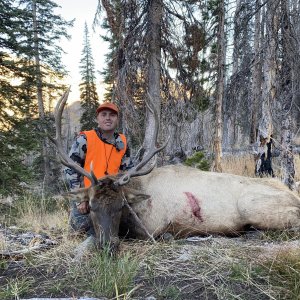Ok, this may sound like a stupid question but here goes. Since copper ammo is hard to find where I'm at and primers are still an issue for reloading, can I simply take a factory lead cartridge and extract the lead bullet and insert a copper one? That sounds way too simple so I'm guessing I'd probably have to dump the powder out and start over with a known recipe. Thoughts?
You are using an out of date browser. It may not display this or other websites correctly.
You should upgrade or use an alternative browser.
You should upgrade or use an alternative browser.
Replacing Lead with Copper
- Thread starter Bow6x6
- Start date
Cahunter805
Long Time Member
- Messages
- 3,345
Definitely a no. What cartridge you looking for?
diablo
Very Active Member
- Messages
- 1,012
That should be no problem. There’s a number of sources listed on AmmoSeek right now.

 ammoseek.com
ammoseek.com

.270 Win Ammo
In-stock best prices for 270 Win Ammo | Bulk 270 Win Ammunition - AmmoSeek.com
myj
Active Member
- Messages
- 134
This is what I did for my 300 Weatherby: I shot a few of the factory loads thru the chronograph to get a base on factory cartridge velocity thru my rifle. I then pulled the 180 gr. SGK's from a number of cartridges, I think it was 12, and reduced the original powder charge by 10% and incrementally increased the powder weight by 2 grains at a time until I reached the full load. Since I observed no high-pressure signs and velocity was comparable, I then seated the 180 gr. TSX's. I ended up with a great load with no problems. Next time I do this I plan to neck size the brass for a good tight hold although bullet slippage has not been a problem.Ok, this may sound like a stupid question but here goes. Since copper ammo is hard to find where I'm at and primers are still an issue for reloading, can I simply take a factory lead cartridge and extract the lead bullet and insert a copper one? That sounds way too simple so I'm guessing I'd probably have to dump the powder out and start over with a known recipe. Thoughts?
LIK2HNT
Long Time Member
- Messages
- 3,392
Good way to get hurt. Many copper bullets create higher pressure than lead. Since it sounds like you do not have primers, I will assume you have powder and copper bullets. If anything I would pull the bullets, pour out the powder, and reload with a recipe for copper. Weight and save the powder and you can reload it later for target practice with the lead bullets.
RELH
Long Time Member
- Messages
- 17,479
When copper bullets first came out, the bullets did not have grooves and as a result more friction was created resulting in higher pressure readings with a load that was fine with standard bullets. Blown primers were a problem with some loads.
Most of today's all copper bullets have 2 or 3 grooves that reduce the friction down to similar pressure you would get with a standard bullet.
Another problem with factory powders is that they use powder that reloaders may not be able to get to duplicate their loads.
RELH
Most of today's all copper bullets have 2 or 3 grooves that reduce the friction down to similar pressure you would get with a standard bullet.
Another problem with factory powders is that they use powder that reloaders may not be able to get to duplicate their loads.
RELH
Zeke
Long Time Member
- Messages
- 10,603
I'm sure that in most cases it's just fine but.... there's always the chance that you'll be introducing higher pressures than you'd want. Typically factory rifle ammo is loaded pretty dang hot.
Another variable is seating depth and bullet jump and I have no way of knowing that you'd get that right.
Zeke
Another variable is seating depth and bullet jump and I have no way of knowing that you'd get that right.
Zeke
willfrye027
Active Member
- Messages
- 316
If you have the tools to deconstruct and reload a bullet, why not just make some fresh reloads? Hammer bullets are always available and work extremely well on game from my experience. I work up loads for a handful of friends in their rifles using the hammers. Just did a 270wsm with 117hammer hunter and h4350 going 3400fps and it’s a grain below any pressure signs. Load development took about 15 rounds total; they’re very easy to load for.
Homer
Long Time Member
- Messages
- 14,205
Anyone here try out any Maker bullets??....nonlead
Last edited:
idahomuleyhunter
Active Member
- Messages
- 671
If you dump the powder and remeasure to a known recipe you'll be absolutely fine. It's no different than buying primed brass. might check neck tension.Ok, this may sound like a stupid question but here goes. Since copper ammo is hard to find where I'm at and primers are still an issue for reloading, can I simply take a factory lead cartridge and extract the lead bullet and insert a copper one? That sounds way too simple so I'm guessing I'd probably have to dump the powder out and start over with a known recipe. Thoughts?
idahomuleyhunter
Active Member
- Messages
- 671
Factory ammo is loaded to SAAMI specs. If you seat the new bullet to SAAMI specs why would you think you'd have pressure issues? Unless you change bullet weight. If you want to seat longer for your rifle you should still be able to measure to the ogive and calculate the seating depth to get you to your proper distance from the lands.I'm sure that in most cases it's just fine but.... there's always the chance that you'll be introducing higher pressures than you'd want. Typically factory rifle ammo is loaded pretty dang hot.
Another variable is seating depth and bullet jump and I have no way of knowing that you'd get that right.
Zeke
RELH
Long Time Member
- Messages
- 17,479
All copper bullets will cause higher friction that elevates pressure over lead bullets with a copper jacket. All copper bullets does not squeeze down as easy to fill the grooves in the rifle barrel and this is the leading cause to higher friction and pressure levels.
so removing a lead-copper jacket bullet and installing a all copper bullet in it's place can lead to higher pressure even if you use the same weight bullet and seat to the same length.
RELH
so removing a lead-copper jacket bullet and installing a all copper bullet in it's place can lead to higher pressure even if you use the same weight bullet and seat to the same length.
RELH
Hammers mostly eliminate these issues. Especially the Absolute line of bullets. mtmuleyAll copper bullets will cause higher friction that elevates pressure over lead bullets with a copper jacket. All copper bullets does not squeeze down as easy to fill the grooves in the rifle barrel and this is the leading cause to higher friction and pressure levels.
so removing a lead-copper jacket bullet and installing a all copper bullet in it's place can lead to higher pressure even if you use the same weight bullet and seat to the same length.
RELH
idahomuleyhunter
Active Member
- Messages
- 671
There is no "squeezing" happening. Copper is less dense than lead, therefore a solid copper bullet of the same weight must by definition be larger than it's cup and core counterpart. This means the copper solid will have more bearing surface than the cup and core. And it's sliding friction that builds pressure not "squeezing." Barnes uses cannelures to reduce some of this surface area.All copper bullets will cause higher friction that elevates pressure over lead bullets with a copper jacket. All copper bullets does not squeeze down as easy to fill the grooves in the rifle barrel and this is the leading cause to higher friction and pressure levels.
so removing a lead-copper jacket bullet and installing a all copper bullet in it's place can lead to higher pressure even if you use the same weight bullet and seat to the same length.
RELH
Taking a quick look at reloading manuals for Barnes and Nosler you'll notice that the powder charges(I'm looking at 270wsm) don't change much and in some instances Barnes has a higher max charge for a given powder. If you buy factory ammo and put a new bullet of the same weight in you are not going to blow yourself up. SAAMI isn't there to tell you where the max is it's to make sure you have ample margin of error. That said call and ask what powder is in the case, if it's not listed on the box, then you should feel more than comfortable doing this.
RELH
Long Time Member
- Messages
- 17,479
I also used the Hogdon powder site and there is a difference of using less powder for a load with all copper bullets versus a standard cup & core bullet. All copper bullets are harder and less malleable then a standard cup & core bullet.
A reloader using all copper bullets would be wise to use the data for the all copper bullet and not just remove the cup & core bullet from a loaded factory round and replacing with a all copper bullet leaving the powder charge the same. He may get by with it, then again he may get a big surprise when he pulls the trigger.
Feel free to do what you want, it is your rifle.
RELH
A reloader using all copper bullets would be wise to use the data for the all copper bullet and not just remove the cup & core bullet from a loaded factory round and replacing with a all copper bullet leaving the powder charge the same. He may get by with it, then again he may get a big surprise when he pulls the trigger.
Feel free to do what you want, it is your rifle.
RELH
idahomuleyhunter
Active Member
- Messages
- 671
It has absolutely nothing to do with malleability. The bullet is not being deformed as it travels thru the barrel. A cup and core bullet has the exact same bearing material as a copper bullet, copper. The bearing surface in both(assuming pure copper and not alloys) is in fact copper. Thus the coefficient of friction is the same. The difference is surface area. A solid copper bullet of the same weight and diameter necessarily has more surface area, it has to be bigger. Resulting in more sliding friction and higher pressures. If an ammo manufacturer put the charge in a cartridge you can bet it won't blow up a modern rifle, they have lawyers on staff too.
idahomuleyhunter
Active Member
- Messages
- 671
Where does that copper fouling in my barrel come from?
It's being sheared off. The force is parallel to and opposite in direction of bullet travel. Not perpendicular to the bullet.
It's being sheared off. The force is parallel to and opposite in direction of bullet travel. Not perpendicular to the bullet.
Last edited:
idahomuleyhunter
Active Member
- Messages
- 671
https://riflebarrels.com/a-look-at-bolt-lug-strength/
Since 4140 type chrome-moly is probably the most common type of steel used in bolts, I’m including a list of the yield strength for this steel at various Rockwell `C’ hardness values.
Since 4140 type chrome-moly is probably the most common type of steel used in bolts, I’m including a list of the yield strength for this steel at various Rockwell `C’ hardness values.
| ROCKWELL ‘C’ HARDNESS | 4140 YIELD STRENGTH PSI |
| 20 | 83,500 |
| 22 | 87,000 |
| 30 | 135,000 |
| 34 | 148,750 |
| 37 | 159,000 |
| 42 | 178,000 |
| 46 | 195,000 |
| 49 | 211,000 |
idahomuleyhunter
Active Member
- Messages
- 671
SAAMI maxes pressures out at around 60-65k psi for most cartridges. The extra 2-3k psi from switching like weight bullets isn't going to blow up a rifle.
RELH
Long Time Member
- Messages
- 17,479
Did you just ignore the possibility of a blown primer. I guess you do not mind getting a eyeful of blown particles coming back at you though the bolt firing pin hole.
Like I said, your rifle do what you want. Just do not do it around me. Your statement about the bullet not being deformed upon firing is laugh full at best since the rifle lands do not engrave the bullet according to you.
RELH
Like I said, your rifle do what you want. Just do not do it around me. Your statement about the bullet not being deformed upon firing is laugh full at best since the rifle lands do not engrave the bullet according to you.
RELH
LIK2HNT
Long Time Member
- Messages
- 3,392
Sorry, rifling creates a forces both parallel and perpendicular to the bullet. Basic physics. Any force vector has a X and Y components. One may be zero only if the force is directly inline with one of the axis. Which rifling is not.Where does that copper fouling in my barrel come from?
It's being sheared off. The force is parallel to and opposite in direction of bullet travel. Not perpendicular to the bullet.
Zeke
Long Time Member
- Messages
- 10,603
IDMuleyHunter.
You obviously know lots and are quite intelligent but you've forgotten the wisdom of never substituting components without doing some safe work-up.
Let's look at real-world for a second: I went from a 140 grain cup and core in a .264 to a 124 mono-metal bullet. One would "think" I could use a fair bit more powder with that much bullet weight drop yet testing yielded that I can only use 59.5 for the mono v 59.0 of RL-26 for the much larger cup and core bullet. Weird, huh?
And.... most mono bullets are pure copper and most cup and core are gilding metal, which by nature is more "slippery" in the bore.
Best to you sir,
Zeke
You obviously know lots and are quite intelligent but you've forgotten the wisdom of never substituting components without doing some safe work-up.
Let's look at real-world for a second: I went from a 140 grain cup and core in a .264 to a 124 mono-metal bullet. One would "think" I could use a fair bit more powder with that much bullet weight drop yet testing yielded that I can only use 59.5 for the mono v 59.0 of RL-26 for the much larger cup and core bullet. Weird, huh?
And.... most mono bullets are pure copper and most cup and core are gilding metal, which by nature is more "slippery" in the bore.
Best to you sir,
Zeke
Sallaberry
Very Active Member
- Messages
- 1,027
If you’re in a pinch I have 50 nolser pre primed cases pm me.
Cahunter805
Long Time Member
- Messages
- 3,345
Here’s 2 boxes of 130gr Barnes loaded ammo. Seller is a good guy also.

 www.longrangehunting.com
www.longrangehunting.com

Barnes/Hornady Factory ammo- 6.5, 270, 300
Barnes .270 130gr: $60 per box SOLD - Hornady 6.5CM 143 ELD-X: $55 per box SOLD— Barnes 300WM 180gr: $60 per box SOLD— Barnes 6.5CM 127 LRX: $55 per box Shipping depends on location.
Good stuff Zeke. mtmuleyIDMuleyHunter.
You obviously know lots and are quite intelligent but you've forgotten the wisdom of never substituting components without doing some safe work-up.
Let's look at real-world for a second: I went from a 140 grain cup and core in a .264 to a 124 mono-metal bullet. One would "think" I could use a fair bit more powder with that much bullet weight drop yet testing yielded that I can only use 59.5 for the mono v 59.0 of RL-26 for the much larger cup and core bullet. Weird, huh?
And.... most mono bullets are pure copper and most cup and core are gilding metal, which by nature is more "slippery" in the bore.
Best to you sir,
Zeke
tailchasers
Long Time Member
- Messages
- 5,288
Sorry if this has been already elated to since I have not read every post. In my experience, the harder I pushed the copper bullet the better they shoot. I am at compressed loads with my 7 mag. And they like a little jump to the lands. I'll be restarting this experiment with a pair of 260 Remingtons very soon. They tend to hold together better than bonded so you can get away with a slightly lighter bullet that seems to like speed making up for the BC loss.












